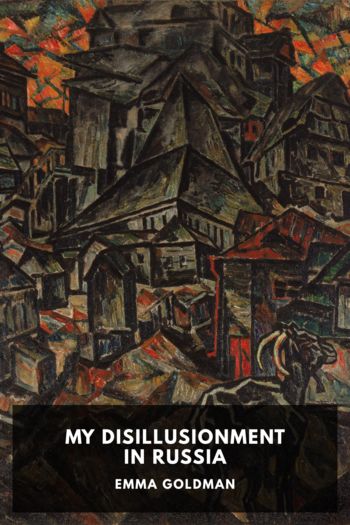Journey from St. Petersburg to Moscow Irina Reyfman (snow like ashes .TXT) 📖

- Author: Irina Reyfman
Book online «Journey from St. Petersburg to Moscow Irina Reyfman (snow like ashes .TXT) 📖». Author Irina Reyfman
By June 1790, Catherine had determined to her own satisfaction Radishchev’s authorship (her initial suspicions that he had an accomplice coauthor were rejected) and that he was, in her words, “a rebel even worse than Pugachev.”7 His arrest followed an investigation directed by Count Alexander Bezborodko, one of Catherine’s most valued statesmen and a man of cultivated sensibility, who argued for leniency. On the one hand, he believed that Radishchev had not violated the letter of the law, since free presses were permitted by a decree of 1783; on the other hand, the immediate context of the French Revolution was impossible to ignore, as were passages in Radishchev’s book urging the establishment of equality and praising the regicide Cromwell. It was no help to Radishchev that the rumor mill about French spies in St. Petersburg had gone into overdrive, including allegations about a suspected plot to assassinate the Empress attributed to the Masonic Martinists, with whom the work’s dedicatee Andrei Kutuzov had links.8 Evidence that the book was a succès de scandale in demand by readers (the documented investigation speaks of “the great curiosity of the public for the book”); that perhaps as many as fifty copies had gone unaccounted for; and that a translation into German was already in preparation (untrue, as it happened) exacerbated tensions. Radishchev was imprisoned in the Peter and Paul Fortress, his interrogation conducted by S. I. Sheshkovsky, who, as the dreaded head of the Secret Chancery, was nicknamed “knout-flogger.” In mid-July Radishchev addressed to Sheshkovsky a letter of extenuation and apology intended for the ruler. The questions put to Radishchev were in effect scripted by Catherine; they asked Radishchev to explain whether he felt “the significance of his crime” and to gloss the meaning of passages regarded as explicitly of criminal intentionality.9 The official charge spoke of a “personal affront” to the Empress and a “determination to stir up the people against their masters.” The death sentence decreed on July 24th was confirmed by the Senate in early September, after Radishchev had been stripped of his rank (legislation forbade the execution of nobles). Catherine commuted the sentence to ten years of Siberian exile. This second decree noted the exceptional gesture of “clemency” (miloserdie), one of the Enlightenment values that differentiated the Enlightened autocrat from the tyrant, in sparing Radishchev, who was then sent east under armed convoy.
In 1811, when Radishchev’s sons published their edition of his works, they omitted the Journey because of the ongoing censorship ban. For most of the nineteenth century, the Journey remained a clandestine book, notwithstanding the anonymous publication of a sporadic chapter or two in journals in Russia and Germany and mentions in works of reference such as Bantysh-Kamensky’s Dictionary of Memorable People (1836). After the political turmoil of 1825, Radishchev’s name was taboo for a decade, and precious few readers had access to his writings. Among them was Alexander Pushkin, who may have read Radishchev’s book in manuscript even before purchasing a rare copy in 1835 (only sixty-seven copies of Radishchev’s printing have been accounted for). One indicator of Pushkin’s engagement with Radishchev’s book can be found in the title of his essay “Journey from Moscow to Petersburg” (1833–35, unfinished). The piece examines the chapters of Radishchev’s Journey in reverse order, providing a set of revisionist commentaries for which Radishchev’s text is always the departure point. It was a sign of the times that in 1837 the minister of education, Count S. S. Uvarov, excluded Pushkin’s article “Alexander Radishchev” from the third volume of his literary journal The Contemporary, extending the ban to the posthumous edition of his works. The ban remained in force until Pavel Annenkov’s important edition of Pushkin’s works in 1857, when the novelist Ivan Goncharov, no less, was the censor.
In 1858, Nikolai Ogarev and Alexander Herzen, exiles based in London and often dubbed the fathers of Russian socialism, published in effect the second edition of Radishchev’s Journey in The Bell (Kolokol) of 1858, their famous radical journal. Although full of errors and unauthorized editorial interventions, this notable edition (reprinted with its distortions in Leipzig in 1876) stimulated Pavel Radishchev in 1859 or 1860 to apply to Tsar Alexander II for permission to publish this and other works by his father. He had published in 1858 his own memoir of his father, partly drawing on rare materials, including a manuscript copy of the Journey provided by the historian Mikhail Pogodin. Pavel succeeded against enormous resistance in publishing his memoir (the censor, reputed to be a secret friend to radicals, lost his job over the matter). However, his efforts to publish the Journey met with refusal in 1860 and again in 1865, during which time he sent Herzen a copy of Radishchev’s massive ode “Liberty” for publication. The ban on the Journey was lifted by the Tsar in March 1868. Rumors of new editions proliferated, and a memoir by Radishchev’s other son, Nikolai, was allowed to appear, while some mentions of Radishchev as the author of the Journey in reference works were tolerated (a fuller version of memoirs by both sons would





Comments (0)